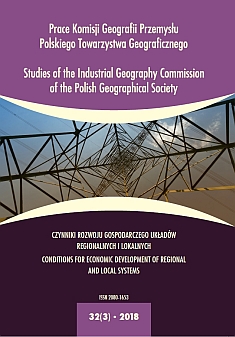The Role of Metallurgy in the Regional Development of Campania (Italy) in the 20th Century
DOI:
https://doi.org/10.24917/20801653.323.12Keywords:
Bagnoli-Coroglio district, Campania region, Italsider/Ilva industrials plants, steel industryAbstract
The problem of growing regional disparities in Italy observed since the 19th century influenced the government’s decision to start investing money in the industrial development of the poorer, Southern regions of the country. The late 19th and early 20th century represented a period in which the economic development was mainly based on steel production. The foundation of the Ilva steelworks in 1910 in the Gulf of Pozzuoli caused a great decrease in the unemployment rate and boosted the development of the whole region. Such a big enterprise increased the economic role of Naples and when it was closed down at the beginning of the 1990s, a lot of people were forced to leave the South of Italy. There were also ecological problems (soil contamination, water pollution). The aim of this article is to analyse the decisions made at the beginning of the 20th century which led to the foundation of the metallurgical plant in Bagnoli. The main aspects taken into consideration are the economic and industrial development factors in the context of the increasing regional disproportions in Italy, as well as the ecological actions taken with regards to tourism development.Downloads
Metrics
References
Amodio, T. (2016). Cartografia e trasformazioni urbane: il caso di Bagnoli. ASITA. Pozyskano z http://atti.asita.it/ASITA2016/Pdf/083.pdf
Cirillo, C., Bertoli, B., Scarpa, L. (2016). Napoli e il paesaggio costiero: Il recupero ambientale di Bagnoli e la rigenerazione del Litorale Flegreo. W: VI Simposio-Il monitoraggio costiero mediterraneo: problematiche e tecniche di misure. Livorno: CRN Italia, 112–118.
Comune di Napoli (2017a, 20 września). Accordo Inter istituzionale Governo Italiano, Regione Campania, Comune di Napoli. Programma di Risanamento Ambientale e Rigenerazione Urbana Area di Rilevante Interesse Nazionale Bagnoli – Coroglio. Roma. Pozyskano z www.comune.napoli.it
Comune di Napoli (2017b, 18 września). Un nuovo modello per la trasformazione urbana di Bagnoli. Napoli. Pozyskano z www.acen.it
Crescenzo, G. de (2016). Noi, I Neoborbonici! Storie di orgoglio Meridionale (I). Milano: Magenes.
De Matteo, L. (2002). L’Unità d’Italia stroncò le imprese del Sud. Napoli: Il Denaro.
De Vito, B. (2007) (2018, 5 lipca). Indagini e risultati per il risanamento dei siti ex industriali dell’area di Bagnoli. Pozyskano z http://www.napoliassise.it/devivocolore.pdf
Ðurić, K. (2010) (2017, 22 grudnia). Le origini e lo sviluppo dell’immigrazione italiana negli Stati Uniti tra il 1870 e il 1930. Universität Wien. Pozyskano z http://othes.univie.ac.at/9247/1/2010-04-06_0204167.pdf
Fedele, C., Di Luccio, A. (2010). Consenso tecnico e integrazione trasporti-territorio: il Progetto Bagnoli.
Giglio, M. (2016) (2018, 6 lipca). Le terme ed i santuario ellenistico di Agnano. Nuovi dati dal territorio di Neapolis e Puteoli, tra il III a.C ed il V d.C. Associazione Internazionale di Archeologia Classica. Pozyskano z http://www.fastionline.org/docs/FOLDER-it-2016-368
Ilva (1961). Bagnoli anni Cinquanta 1911–1961. Italsider (red.). Genova: Arti Grafiche Giuseppe Lang.
Manfrellotti, S. (2004). Cento anni dalla legge per il risorgimento economico della città di Napoli. In Camera di Commercio (red.). Neapol: Labor Historia Industria, 147–156.
Nebbia, G. (2015) (2018, 6 lipca). Con che cosa hanno inquinato? Fondazione biblioteca archivio Luigi Micheletti. Pozyskano z http://www.fondazionemicheletti.eu/contents/documentazione/archivio/Altronovecento/Arc.Altronovecento.10.15.pdf
Noviello, M. (2018). Projekt rewitalizacji dzielnicy Bagnoli jako czynnik wzrostu gospodarczego Neapolu. Przedsiębiorczość–Edukacja (w druku).
Noviello, M., Noviello, A., Noviello, F. (2015). Problemy rozwoju turystyki w Neapolu. W: A. Dłużewska, G. Iwanicki (red.). Geograficzne i ekonomiczne uwarunkowania rozwoju turystyki. Lublin–Krosno: Wydawnictwo ARMAGRAF, 137–146.
Pelaggi, S. (2016). L’altra Italia. Emigrazione storica e mobilità giovanile a confronto. Roma: Edizioni Nuova Cultura.
Pentena, F., Conforto, B. (1951). Risultati di sondaggi e ricerche geominerarie nei Campi Flegrei per vapore, acque termali e forze endogene in generale. Annali di Geofisica, 4(3), 369–385.
Repubblica (1984) (2017, 15 listopada). L’Italsider di Bagnoli può raddoppiare la sua produzione. La Repubblica. Napoli. Pozyskano z http://ricerca.repubblica.it/repubblica/archivio/ repubblica/1984/10/12/italsider-di-bagnoli-puo-raddoppiare-la.html
Tintori, G. (2013). Italy: The Countinuing History of Emigrants Relations. W: M. Collyer (red.). Emigration Nation. Policies and Ideologies of Emigrant Engagement. Huondmills Basingstoke: Palgrave Macmillian, 126–152.
Tolaini, R. (2005) (2017, 12 grudnia). Ilva-Italsider. Storia. Pozyskano z http://www.storiaindustria.it/home/ Vito, M. (2010). L’impatto dell’industria nel distretto di Napoli. Ecoscienza, 3, 106–108.
Downloads
Published
How to Cite
Issue
Section
License
Articles are published under the terms of the Creative Commons License (CC BY-ND 4.0; Attribution– NoDerivs).

